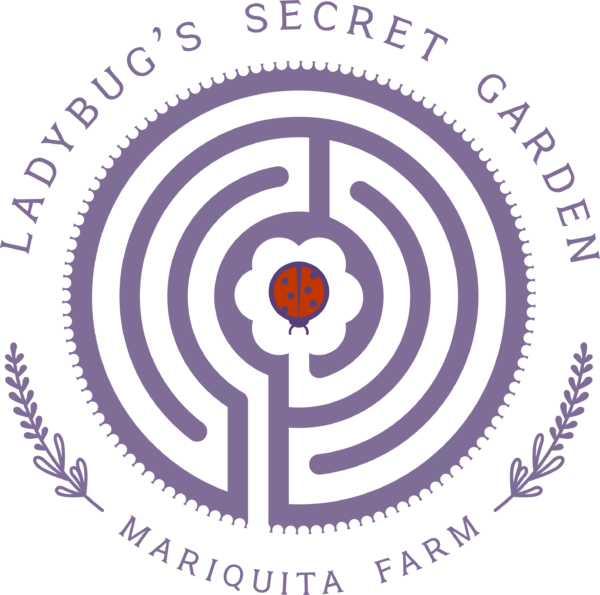Tomato Update
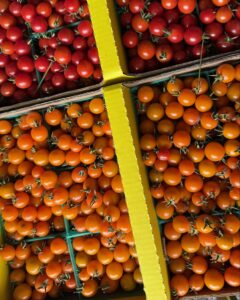
The season’s first Cherry Tomatoes
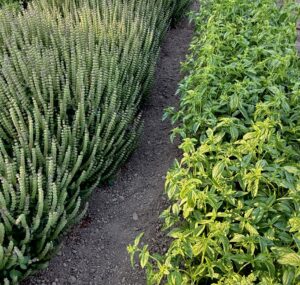
Tulsi basil from India on the left, Genovese basil on the right
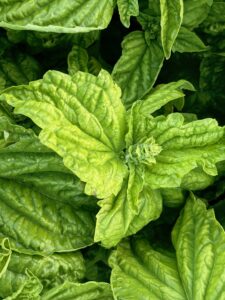
Napolitano basil, also known as “Lettuce Leaf basil”
Hi Friends: San Marzano, or “Saint Marcian” to English speakers, achieved notoriety within the Roman Empire as the first Bishop of Tortona. The historical record is blurry but Marzano was either crucified by Emperor Trajan in 117 AD or by Trajan’s successor, Hadrian, a few years later in 120 AD. Christian martyrdom earned Marzano his saintly status within the Roman Catholic Church but he achieved a wider immortality in the world of food. Tortona is near Genoa in the north of Italy. Genoa, of course, is famous in its own right because of their “Genovese” basil, said by some to be the ONLY appropriate basil for perfect pesto. Basil and tomatoes go together like cookies and milk, but the saintly, rmeaty, red, sausage-shaped sauce tomato doesn’t come from Marzano’s Bishopric but from the town of San Marzano sul Sarno in Campania, near Mt Vesuvius, in Southern Italy.Even if you’ve never tasted a ripe San Marzano tomato, you’ve likely seen an iconic image of the long, cylindrical tomato on the cans of imported tomato sauce stacked high in Italian delicatessens.

Piccolo Fino Verde basil. Piccolo means “tiny,” like the little flute. But this basil packs a huge scent!
Marzano could never have tasted his namesake tomato because Italians had to wait another 1400 years after his death for the Spanish Catholics to invade Mexico in 1519 AD and encounter all the miraculous crops that the native American farmers had developed. Even more time elapsed for these “New World” crops like tomatoes, peppers, cacao, corn, squash and beans to make their way back to Europe. Initially these “new” crops were regarded with suspicion; since none of them were mentioned in the Holy Bible it was feared that they were Satanic. It fell to any number of nameless Italian gardeners and cooks who weren’t overly concerned with the Theology of botany to convert these imported pagan crops into “Italian” food.
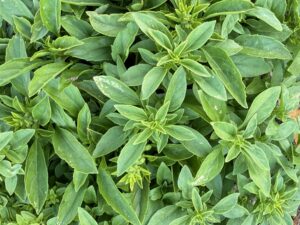
Greco a Palla basil, or Greek basil. No, the Greeks did not invent basil, but they made it their own.
Poor Marzano couldn’t have tasted authentic Genovese basil pesto either, because the basil plant was developed by SouthEast Asian farmers. Muslim spice traders would have been responsible for introducing basil into the Mediterranean and European cultures. The best pesto is an emulsion of basil leaves, lemon juice, olive oil, and pine nuts. Arab Muslims are responsible for introducing the lemon to Italy too. At least Italians can take credit for the pine nuts in their pesto which come from the native Italian Stone Pine, Pinus pinea. When we start our tomato pop-ups in August we will have a rainbow of basils on the table along with San Marzano tomatoes.
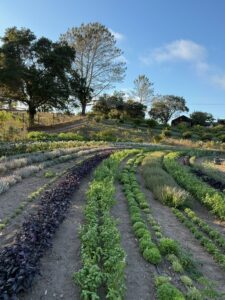
Purple basil growing next to other herbs on the farm. The pine in the background is a Torrey Pine. It would yield cones with fabulous pine nuts, but the tree squirrels get them all.
We will also have Piennolo tomatoes for sale. Piennolo tomatoes came to fame from the region around Mt. Vesuvius in Southern Italy, near Naples. Where the San Marzano tomato is big, long, and meaty, the Piennolo is small and a bit more acidic, with a more concentrated flavor. Piennolo tomatoes have gained fame because they will last a long time after harvest without spoiling. It became traditional for Neopolitan gardeners to hang the season’s last Piennolo plants from the rafters of their kitchens as winter approached, the wilting plants still laden with clusters of small, firm, green, pointed fruits. As the Piennolo’s foliage slowly dried the green, hard fruits would gradually ripen in the warmth of the kitchens so that the cooks could reach up overhead and pluck a few ripe, red tomatoes from the withered vines to flavor a salad or a sauce.
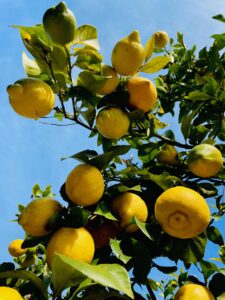
Opinions differ on what ingredients are appropriate in true basil pesto, but most folks allow lemon juice as the acid to balance the olive oil. We grow a wide range of citrus. These are Lisbon lemons.
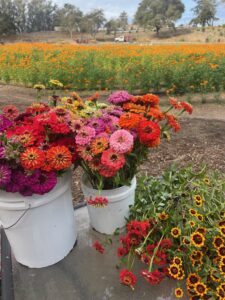
We grow a lot of cut flowers along with the fruits and herbs. Need flowers for an event or gift?
This appealing narrative of ripe tomatoes for a hearty meal on a frosty night is fun and factual but it partly obscures the truth that Piennolo tomatoes are great all season long; you don’t have to wait until the late fall to enjoy them. Piennolos are a lovely tomato for eating fresh, for saucing, and for drying. We like to cut them in half, dehydrate them and then pack them tight in little jars that we fill with olive oil. Not only do the tomatoes taste great, the olive oil that has been steeped in the tomatoes is a revelation. Naples, where Piennolos found their fame, is also the home of “Napolitano Basil,” a very large-leaved, sweet basil that is excellent for salads, garnish, and for wrapping up little bites of food a la grape leaves or fig leaves. Also- don’t sue me- Napolitano basil is appreciated by some people as a good pesto basil.
Principe Borghese tomatoes are easy to confuse with Piennolo tomatoes because they are similar in size and shape to their Neopolitan cousins but we grow them anyway. I’m confused too because, while the Principe Borghese tomato became widely produced in Southern Italy in the early 1900s for the sun-dried tomato industry, the name refers to the famous Borghese clan from the Siena region north of Rome. The Borghese family is famous for creating politicians and popes, not tomato growers. We find that sun-drying any kind of tomato is almost impossible because our regular night time marine fog rehydrates the fruit that our midday sun just dehydrated. But with an electric dehydrator in our kitchen we can make lots of “sun-dried” tomatoes. If I had to make a distinction between the Principe Borghese and Piennolo tomatoes I’d say that the Borgheses are typically a bit juicier than the Piennolo, a bit more pointed at the tip, and that their harvest starts a bit earlier.And, speaking of “early,” we will again be harvesting our dry-farmed Early Girl tomatoes. I saw the first color in our 2025 Early Girl crop today, which is what prompts today’s note to you. The plants look healthy and loaded with fruit. Dry-farm practices assure a rich flavor. It works like this:
1.Transplant sturdy little tomato plants into moist soil in early spring. For us, that means a transplant date of around April 15th, when we no longer fear frost.
2. As the fields dry out from winter rains and the moisture levels retreat into the earth the tomato plant’s roots will follow the water down into the mineral zone below the topsoil.
3. The top soil may be the richest zone for the nitrogen, phosphorus, and potassium, or the “NPK,” which are responsible for helping plants become big, green, and fluffy, the trace elements and micronutrients found in the mineral subsoil are most helpful in giving flowers their color or fruits their flavor. True, dry-farmed plants grow more slowly and the fruit is typically smaller, but they make up for it by having a richer, more complex flavor. We also dry-farm our San Marzano, Piennolo, and Principe Borghese tomatoes. We have found that dry-farming also acts to reduce disease pressure and to reduce the power bills that come from running the irrigation pumps.
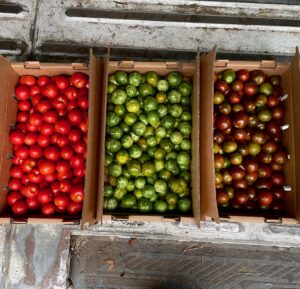
Dry farmed Early Girls on the left, Green Zebra tomatoes in the middle, and Black Prince tomatoes on the right.
We do occasionally irrigate some of our Heirloom tomato varieties, as they might have been developed in places that receive summer rains. Our 2025 crop of Heirlooms looks good at this point- a little late, perhaps, but still on track. As usual, the Purple Cherokee tomatoes will come first, followed by the red, yellow, and pink Brandywines, the Marvel Stripes, the orange Valencias, and the green Aunt Ruby’s German tomatoes.
Last, and smallest, but not least, we have a rainbow of cherry tomatoes coming your way, from the popular Sungold and Sweet 100s all the way through black, purple, and yellow varieties to the tiny, pea-sized wild cherry toms. It’s going to be a good year. Keep your eye on the newsletter for details of upcoming pop-ups and farm events.
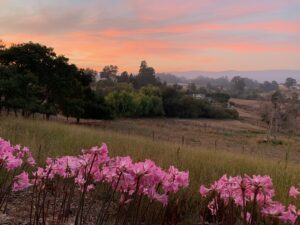
The farm is available as an event space for small weddings, elopements, team-building events, etc. These amaryllis are an event in and of themselves!
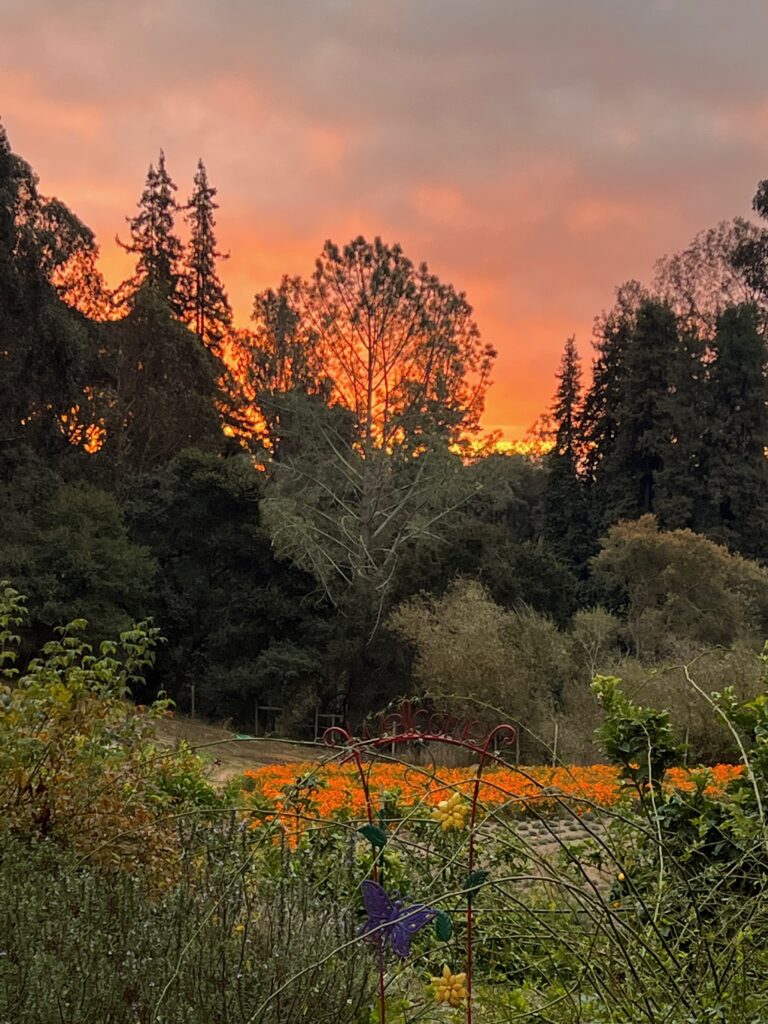
Keep an eye out for our 2025 season Marigold U-Pick events. Here the sky seems to be soaking up color from the flowers.
Also coming up at the pop-ups we will have Basilico Piccolo Fino, Purple Basil, Cinnamon Basil, Greco a Palla Basil, Thai Basil, Tulsi Basil, Oregano, Savory, Sweet Marjoram and Zaatar, or Syrian Marjoram.

.
|
